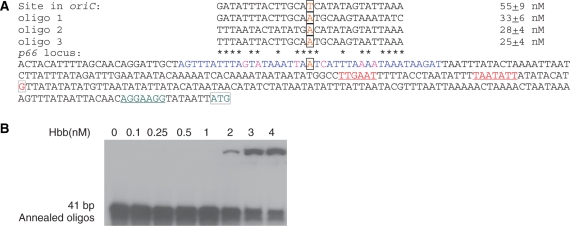Figure 5.
The p66 promoter region and Hbb-binding sites. (A) The p66 upstream region is shown 5′–3′ with the −35 and −10 highlighted in red, the transcriptional start site highlighted in red (29), the putative ribosome binding site in green, the translational start site in green, and the candidate Hbb binding site tested by EMSA highlighted in blue. Mismatches to a perfect palindrome within this site are highlighted in pink, the base at the axis of symmetry is in orange. The DNA sequences bound by Hbb and their affinities are from (46,62). Their binding site studies were refined with double stranded oligonucleotides (designated oligo 1, oligo 2 and oligo 3 in the alignment, shown without flanking 10 bp fragments) designed to test the roles of symmetry and IHF consensus sequences (62). The p66 bases that are exact matches to the sequences bound by Hbb with affinities of <30 nM are indicated by black asterisks. (B) Hbb binds to the 41 bp region shown in blue in (A). The DNA fragment was formed by annealing two oligonucleotides, and tested for binding to Hbb by EMSA as described in Figures 3–5, with the exception that the samples were run on a higher percentage acrylamide gel.

